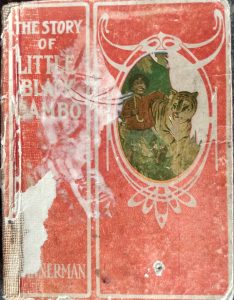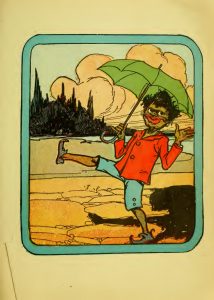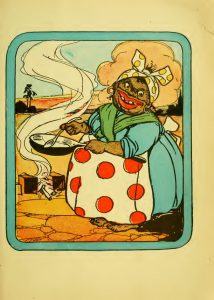Source
Click here to view the digital edition.
Description
This disturbing adaptation reduces Sambo and his mother to grotesque caricatures of Black people. Illustrator John R. Neill did not alter Bannerman’s original text, but he visually represents Little Black Sambo as animalistic and savage. This Sambo has exaggerated, bright red lips and large white eyes, features that evoke minstrelsy imagery. When he isn’t dressed in his “grand” clothes, he wears what appears to be a grass skirt or a tattered loincloth, reinforcing his unflattering portrayal as an uncivilized African. Bizarrely, Neill also draws Sambo with curled, elf-like shoes, contributing to the boy’s dehumanization.
The book’s final illustration features Black Mumbo, drawn here as a barefoot, gap-toothed, red-lipped Mammy figure. African American studies scholar Kimberly Wallace-Sanders notes that the Mammy caricature derives from antebellum fiction and the slave plantation. Typically rendered as an obese, black-skinned, middle-aged woman who wears an apron and a headscarf, the Mammy is a “jolly presence” that was used to justify slavery. As a result, Neill’s representation of Black Mumbo as a Mammy figure perpetuates harmful misrepresentations of Black women as happy domestic slaves.
Creator
Helen Bannerman
Contributor(s)
Illustrated by J. R. Neill
Publisher
Reilly & Lee
Publication Date
1908
Format
56 pages; colored illustrations; unknown dimensions
Language
English




